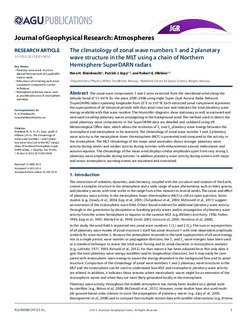| dc.contributor.author | Kleinknecht, Nora | |
| dc.contributor.author | Espy, Patrick Joseph | |
| dc.contributor.author | Hibbins, Robert | |
| dc.date.accessioned | 2018-02-09T14:16:24Z | |
| dc.date.available | 2018-02-09T14:16:24Z | |
| dc.date.created | 2014-05-20T11:03:47Z | |
| dc.date.issued | 2014 | |
| dc.identifier.citation | Journal of Geophysical Research - Atmospheres. 2014, 119 (3), 1292-1307. | nb_NO |
| dc.identifier.issn | 2169-897X | |
| dc.identifier.uri | http://hdl.handle.net/11250/2483792 | |
| dc.description.abstract | The zonal wave components 1 and 2 were extracted from the meridional wind along the latitude band of 51–66°N for the years 2000–2008 using eight Super Dual Auroral Radar Network (SuperDARN) radars spanning longitudes from 25°E to 150°W. Each extracted zonal component represents the superposition of all temporal periods with that zonal structure and indicates the total planetary wave energy available with that wave number. The Hovmöller diagrams show stationary as well as eastward and westward traveling planetary waves propagating in the background wind. The method used to detect the zonal planetary wave components in the SuperDARN data are detailed and validated using UK Meteorological Office data, which allows the evolution of S1 and S2 planetary wave energy between the stratosphere and mesosphere to be assessed. The climatology of zonal wave number 1 and 2 planetary wave activity in the mesosphere-lower thermosphere (MLT) is presented and compared to the activity in the stratosphere. The MLT climatology of the mean wind anomalies shows stronger planetary wave activity during winter and weaker activity during summer with enhancement around midsummer and autumn equinox. The climatology of the mean wind displays similar amplitudes apart from very strong S1 planetary wave amplitudes during summer. In addition planetary wave activity during winters with major and minor stratospheric warming events are examined and contrasted. | nb_NO |
| dc.language.iso | eng | nb_NO |
| dc.publisher | American Geophysical Union | nb_NO |
| dc.title | The climatology of zonal wave numbers 1 and 2 planetary wave structure in the MLT using a chain of Northern Hemisphere SuperDARN radars | nb_NO |
| dc.type | Journal article | nb_NO |
| dc.type | Peer reviewed | nb_NO |
| dc.description.version | publishedVersion | nb_NO |
| dc.source.pagenumber | 1292-1307 | nb_NO |
| dc.source.volume | 119 | nb_NO |
| dc.source.journal | Journal of Geophysical Research - Atmospheres | nb_NO |
| dc.source.issue | 3 | nb_NO |
| dc.identifier.doi | 10.1002/2013JD019850 | |
| dc.identifier.cristin | 1133604 | |
| dc.relation.project | Norges forskningsråd: 223252 | nb_NO |
| dc.description.localcode | ©2014. American Geophysical Union. All Rights Reserved. | nb_NO |
| cristin.unitcode | 194,66,20,0 | |
| cristin.unitname | Institutt for fysikk | |
| cristin.ispublished | true | |
| cristin.fulltext | original | |
| cristin.qualitycode | 2 | |
